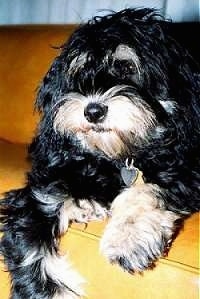
This is Corn Dog at 7 months old
The coat of the Portuguese Sheepdog is either long and smooth or with a slight wave. It does not have an undercoat. Colors include yellow-red chestnut, gray, fawn, wolf or black. A few white hairs are permissible but patches of white hairs are not, except for white patches on the chest. The forelimbs are symmetrically covered with long hair. It has a beard, which gives it a mature look. The eyes are round and dark, with a gentle expression. The moderately sized ears usually hang down the sides of the cheeks, but sometimes they are cropped. Cropping is banned in some European countries. For his moderate size, the dog appears rather high on the legs. His feet are particularly adaptable to rough terrain. His legs are strong and his chest is deep. The hair is longer on the head, giving the dog bangs and a banged-up untidy look. It has a wide, sturdy head with a prominent nose, and strong jaws and teeth. The tail is pointed, reaching the dog's hocks.
One of the most devoted and clever of the sheepdogs, this is a high-spirited, happy dog that is eager to work. Very loyal and bonds with its own people, the Cão da Serra de Aires demands extremely consistent and well-balanced training. It has a lively, above-average intelligence and learns quickly and easily, but can be dominant and will be stubborn if it senses its owners are not as strong minded as itself. Therefore, they have always been a challenge for shepherds to train. Once trained, this dog is more reliable than any owner could possibly wish. It requires a confident, firm handler. These dogs mix well with other dogs, although some males may try to dominate other males. They can live happily alongside other pets provided they have been properly socialized. Portuguese Sheepdog are usually patient with children but the males in particular can be possessive of their territory. This breed is reserved with strangers and makes a good watchdog. It tends to like only the livestock it cares for and its master; these it will defend tirelessly. This all-purpose shepherd has proven outstanding in both guarding and herding sheep, cows, horses and pigs. These dogs are known for their quick, clever attitude and are particularly adept at bringing back strays. They love their master "above everything on earth." It is said that it is unlikely to snap or bite unless provoked
Height: 16 - 22 inches (41 - 56 cm)
Weight: 26 - 40 pounds (12 - 18 kg)
-
The Portuguese Sheepdog is not recommended for apartment life. Assuming it gets enough exercise it will be calm indoors. As a working dog with a need for exercise, it prefers living outdoors, but does enjoy an occasional visit in the home.
The Portuguese Sheepdog has extreme stamina. If it gets enough exercise, including a daily, long walk, it will be calm in the house. This breed does very well in agility.
About 12-13 years.
About 3 - 6 puppies
Check the all-weather coat regularly for tangles but do not brush the coat too much, as it will affect the texture and the rough look. Trim any excess hairs between the pads of the feet. This breed should be shampooed only when necessary.
The Portuguese Sheepdog is almost 100 years old. This shaggy, all-purpose herder, drover and guardian dog from the southern plains of Portugal may descend from Briards imported by Count de Castro Guimaraes, which then bred with local mountain dogs. Although he appears similar to the Berger des Pyrenees and the Catalan Sheepdog, no reliable evidence is forwarded to suggest a direct line of ancestry. For most of the 1900s, the Cão da Serra de Aires was the companion of poor shepherds in southern Portugal, but by the 1970s it was almost extinct. Fortunately, the beauty of its coat and its docile disposition came to the notice of breeders, and today its appeal to middle-class Portuguese dog owners ensures its survival. Although it is virtually unknown outside its native land, this shaggy-looking canine is a class dog, worthy of more international recognition. Owners say that these little "monkey dogs," nicknamed for their peculiar-looking muzzle and quaint expression, have been a part of the farming operation and family life for as long as they can remember. As with many working breeds, workability was more important than looks, and the standard was not fixed until 1930.
Herding